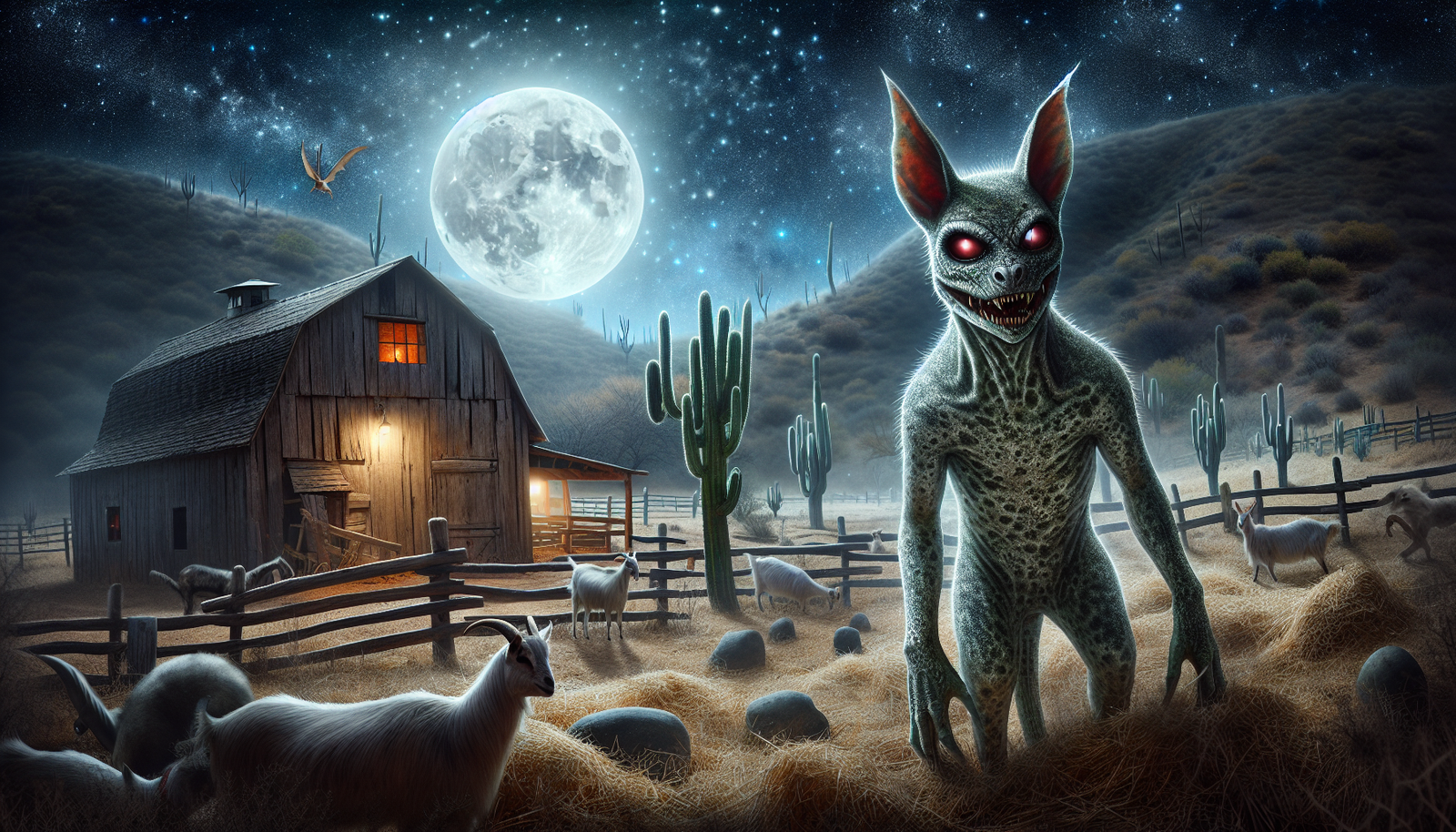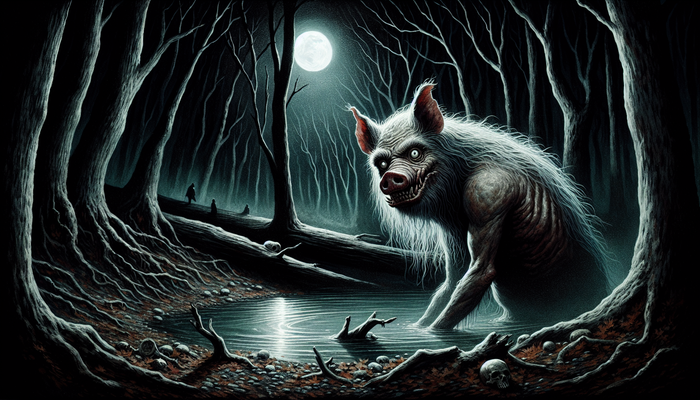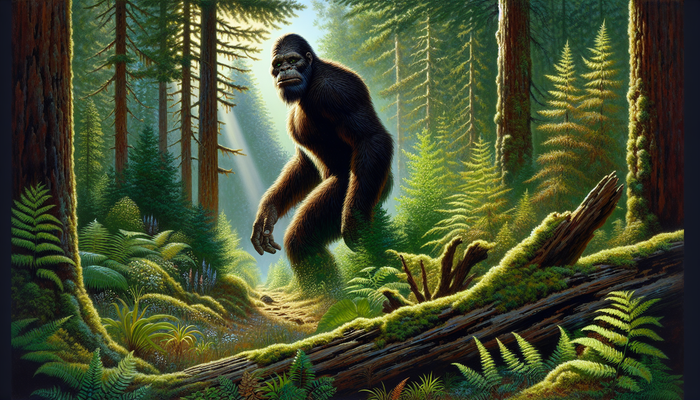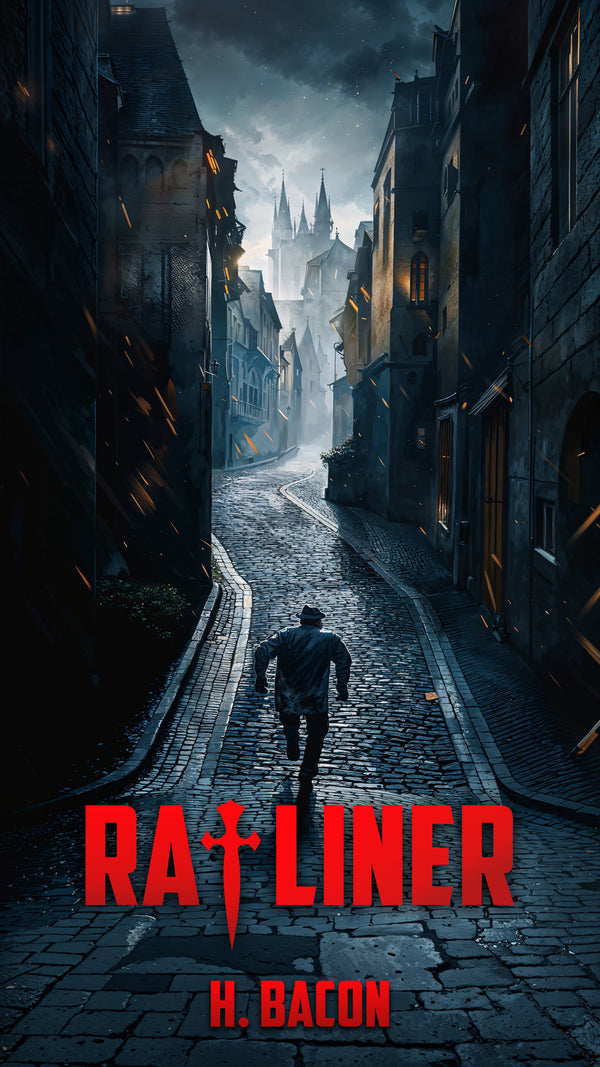Uncovering the Mysteries of Mexico Cryptids

By Wade Beaumont, Cryptozoologist
The Chupacabra: Mexico's Notorious Goat-Sucker
You're a rancher in rural Mexico, making your usual rounds at dawn. As you approach your livestock, a chill runs down your spine. There, lying motionless, are several of your prized goats, their bodies eerily drained of blood. Two small puncture wounds on each carcass tell a chilling tale—the Chupacabra has struck again.
The name "Chupacabra" literally translates to "goat-sucker," and it's a fitting moniker for this vampiric beast. First reported in Puerto Rico in 1995, the legend quickly spread to Mexico, where it found fertile ground in the imaginations of locals. Descriptions of the creature vary wildly, like a game of monstrous telephone. Some swear it's a hairless, dog-like beast with a row of spines running down its back. Others insist it's more reptilian, with leathery skin and glowing red eyes that pierce the darkness.
But here's where it gets interesting: many supposed Chupacabra sightings have a far more mundane explanation. In 2007, a woman in Cuero, Texas, just north of the Mexican border, claimed to have found the carcass of a Chupacabra. The discovery caused quite a stir, but when scientists got their hands on the remains, they found something far less sensational—a coyote with a severe case of mange. This skin condition can cause an animal to lose its fur, giving it an alien, reptilian appearance that matches many Chupacabra descriptions to a T.
Despite these rational explanations, the Chupacabra remains firmly entrenched in Mexican culture. Parents use the legend to keep unruly children in line, warning that the creature might come for them if they misbehave. It's become a sort of boogeyman, a cautionary tale that speaks to deeper fears of the unknown lurking in the wilderness.
The Alux: Mayan Spirits of Mischief and Protection
Now, let's venture into the lush Yucatán Peninsula, where another cryptid holds sway over the hearts and minds of the local Maya people. Meet the Alux (pronounced ah-loosh), a pint-sized spirit that's equal parts guardian and trickster.
Imagine a being no taller than your knee, dressed in traditional Maya garb, with a face that could be carved from ancient stone. These are the Alux, and they're not to be trifled with. According to Maya belief, these spirits are as old as the land itself, predating even the sun.
The relationship between humans and Alux is a delicate dance of respect and reciprocity. Farmers who wish to ensure a bountiful harvest might build a small "house" for an Alux on their land. In return for this shelter and regular offerings of food and drink, the Alux will protect the crops from thieves and pests, even summoning rain when needed.
But here's the catch: this arrangement has an expiration date. After seven years, the Alux grows restless. If the farmer doesn't seal up the spirit's house, trapping it inside, the Alux might turn mischievous or even malevolent. They've been known to lead travelers astray in the jungle, hide tools, or cause crops to fail.
The belief in Alux is far from a relic of the past. Many modern Maya still leave offerings at ancient sites, believing the spirits still dwell there. It's a testament to the enduring power of these legends, bridging the gap between ancient traditions and contemporary life.
La Llorona: The Weeping Woman of Mexican Nightmares
As night falls over Mexico's rivers and lakes, a mournful wail echoes across the water. "¡Ay, mis hijos!" (Oh, my children!) The cry sends shivers down the spines of all who hear it, for they know it heralds the approach of La Llorona, the Weeping Woman.
La Llorona's tale is a tragic one, with roots stretching back to the colonial era. The most common version goes like this: A beautiful woman named Maria falls in love with a wealthy man. They marry and have two children, but her husband's eye soon wanders. In a fit of jealous rage, Maria drowns her children in a river. Realizing the horror of her actions, she drowns herself as well. But death offers no peace. Her spirit is condemned to wander the earth, forever searching for her lost children.
The legend of La Llorona serves as more than just a spooky story. It's a cautionary tale, warning against the dangers of unchecked passion and the consequences of abandoning one's maternal duties. Parents invoke her name to keep children from wandering near water at night, much like the Chupacabra is used to enforce good behavior.
But La Llorona's influence extends far beyond the realm of parental warnings. She's become a cultural icon, featured in countless books, films, and works of art. The 2019 horror film "The Curse of La Llorona" brought her legend to a global audience, cementing her status as one of Mexico's most famous supernatural exports.
What makes La Llorona so enduring? Perhaps it's the universal themes her story touches upon—love, loss, guilt, and the sometimes terrible power of a mother's grief. Or maybe it's the way her legend has evolved over time, adapting to reflect society's changing fears and values. Whatever the reason, La Llorona continues to haunt the collective imagination of Mexico and beyond.
The Sisimite: Mexico's Elusive Bigfoot
Deep in the jungles of southern Mexico, where the trees grow thick and the shadows run deep, stories circulate of a creature that's both fearsome and fascinating. They call it the Sisimite, and if the tales are to be believed, it's Mexico's answer to Bigfoot.
The Sisimite is said to inhabit the dense forests of Campeche, Chiapas, and Quintana Roo. Descriptions paint a picture of a massive, ape-like being covered in thick, dark hair. Its face is eerily human-like, with deep-set eyes that glow in the darkness. Witnesses claim it walks upright on two legs, its powerful frame easily pushing through the thick underbrush.
But what sets the Sisimite apart from its North American cousin isn't just its location. This creature is said to possess a chilling ability—a scream so piercing and otherworldly that it can paralyze its victims with fear. Imagine trekking through the jungle, the humid air thick around you, when suddenly a sound unlike anything you've ever heard freezes you in your tracks. That's the power of the Sisimite's cry.
The origins of the Sisimite legend are as murky as the creature's supposed habitat. Some researchers believe it may be rooted in memories of prehistoric apes that once roamed the region. Others see it as a manifestation of the jungle itself—a symbol of the wild, untamed places that still exist in our modern world.
Interestingly, the Sisimite isn't just a creature of folklore. In 2004, a group of researchers embarked on an expedition to track down evidence of the beast. While they didn't manage to capture the Sisimite on film, they did collect numerous eyewitness accounts from local indigenous communities. These stories, passed down through generations, speak of a creature that's both feared and respected—a guardian of the forest that punishes those who disrespect nature.
Whether the Sisimite is a flesh-and-blood animal yet to be discovered by science, a case of mistaken identity, or purely a product of human imagination, its legend serves an important purpose. It reminds us of the mysteries that still exist in the world, and the importance of preserving the wild places where such creatures—real or imagined—might dwell.
La Lechuza: The Owl Witch of Mexican Lore
As twilight descends over the Mexican countryside, a large owl perches on a gnarled old tree. But this is no ordinary bird—its eyes gleam with an unsettling intelligence, and those who know the old stories will hurry indoors. For this might be La Lechuza, the dreaded Owl Witch.
La Lechuza occupies a unique place in Mexican folklore, straddling the line between the natural and supernatural worlds. According to legend, she was once a woman—a powerful witch who made a dark pact to gain the ability to transform into a massive owl. Some versions of the tale say she was wronged by her community and seeks revenge. Others claim she's a manifestation of divine punishment, sent to torment wrongdoers.
Descriptions of La Lechuza vary, but most agree on a few key details. In her owl form, she's said to be much larger than any natural bird, often reaching the size of a human. Her feathers are stark white, and her eyes glow with an eerie red light. Some stories give her human-like hands hidden beneath her wings, all the better to snatch up unsuspecting victims.
La Lechuza's modus operandi is as chilling as her appearance. She's said to lure her prey with a woman's cries, mimicking the sound of a baby in distress or a damsel in danger. Those foolish enough to investigate find themselves face to face with the monstrous owl. What happens next depends on the version of the story—some say she carries her victims off, never to be seen again, while others claim she drives them mad with her unearthly shriek.
But La Lechuza is more than just a monster story. Her legend often serves as a warning against the dangers of the night, particularly for men engaging in less-than-savory behavior. Many tales feature La Lechuza targeting drunks stumbling home from the cantina or unfaithful husbands sneaking out for a rendezvous. In this way, she becomes a sort of dark avenger, punishing those who stray from the path of righteousness.
The legend of La Lechuza also reflects deeper cultural attitudes and fears. The idea of a woman transforming into a predatory creature taps into anxieties about female power and sexuality. It's no coincidence that many versions of the story feature La Lechuza as a scorned or wronged woman seeking vengeance—a common trope in folklore around the world.
Today, belief in La Lechuza remains strong in many parts of Mexico, particularly in rural areas. People hang owl figurines outside their homes, believing they'll ward off the real thing. Some drivers carry salt or scissors in their cars, said to be effective deterrents against the Owl Witch. Whether these precautions are taken out of genuine belief or simply as a nod to tradition, they demonstrate the enduring power of La Lechuza's legend.
The Ahuizotl: Aztec Water Monster
Imagine you're walking along the shore of a secluded Mexican lake. Suddenly, you hear what sounds like a baby crying, coming from somewhere out on the water. Your instinct is to help, but if you know the legend of the Ahuizotl, you'll turn and run as fast as you can in the opposite direction.
The Ahuizotl is a creature straight out of Aztec mythology, but its legend has persisted long after the fall of that mighty empire. Picture a being about the size of a small dog, with slick, water-resistant fur. Its face resembles that of a monkey, while its ears are reminiscent of a human's. But the Ahuizotl's most distinctive—and deadly—feature is its hand-like tail, complete with an extra-long middle finger perfect for snagging unsuspecting prey.
This aquatic monster is said to lurk in the lakes, rivers, and cenotes (natural sinkholes) of Mexico. Its hunting technique is as clever as it is cruel. The Ahuizotl mimics the cries of a distressed infant, luring compassionate humans to the water's edge. Once its victim is close enough, the creature uses its prehensile tail to drag them into the depths.
But the horror doesn't end there. According to legend, the Ahuizotl doesn't simply drown its victims. It has a particular taste for human eyes, teeth, and fingernails. Bodies found after an Ahuizotl attack are said to be intact except for these specific parts. It's a grisly detail that adds an extra layer of terror to the tale.
The Ahuizotl wasn't just a boogeyman to scare children away from dangerous waters. In Aztec culture, it held a significant place in the pantheon of supernatural beings. The creature was associated with Tlaloc, the god of rain and water. Some scholars believe the Ahuizotl may have represented the dangers of water—a force that could give life but also take it away in an instant.
Interestingly, the name "Ahuizotl" was also given to the eighth ruler of the Aztec Empire, who reigned from 1486 to 1502. Whether this was meant to invoke the creature's fearsome reputation or had some other significance is a matter of debate among historians.
While belief in the Ahuizotl as a literal creature has waned in modern times, its influence can still be felt in Mexican culture. The legend serves as a reminder of the respect and caution one should have around bodies of water. It's also become a popular subject in art and literature, its bizarre appearance and cruel habits making it a favorite of artists looking to tap into Mexico's rich mythological heritage.
The Nahual: Shape-Shifting Sorcerers
In the moonlit villages of rural Mexico, whispered tales speak of individuals with a dark and terrible power—the ability to shed their human form and take on the shape of animals. These are the Nahual, and their legend is as complex as it is enduring.
The concept of the Nahual (or Nagual) has its roots in pre-Columbian Mesoamerican belief systems. It's not just a creature, but a person—usually a powerful sorcerer or shaman—who has the ability to transform into an animal at will. The most common forms are those of predators: jaguars, wolves, or large birds of prey. But some stories tell of Nahual taking on more mundane shapes, like donkeys or turkeys, to move undetected among their unsuspecting neighbors.
What sets the Nahual apart from mere shapeshifters is the spiritual component of their transformation. In many indigenous belief systems, every person is born with an animal spirit or alter ego. For most, this connection is spiritual and symbolic. But the Nahual can physically manifest this animal self, merging the human and beast into one being.
The purposes for which Nahual use their powers vary widely depending on the story. Some tales cast them as protectors, using their abilities to guard their communities from outside threats. These benevolent Nahual might transform into a jaguar to chase away bandits or take the form of an eagle to scout for approaching dangers.
But for every story of a heroic Nahual, there are darker tales that paint them as malevolent sorcerers. These evil Nahual are said to use their powers for personal gain, transforming to steal livestock, terrorize enemies, or even harm children. In some regions, unexplained illnesses or misfortunes are blamed on the secret actions of Nahual living among the community.
The fear of Nahual has led to some dark chapters in Mexican history. During the colonial period and beyond, accusations of being a Nahual could be tantamount to a witch hunt. Innocent people, often those who didn't fit in or were seen as outsiders, could find themselves branded as dangerous shapeshifters and face severe consequences.
Despite (or perhaps because of) this troubled history, the legend of the Nahual continues to captivate the imagination. In modern times, the concept has been explored in literature, film, and art, often as a metaphor for the dual nature of humanity or the struggle between our civilized and wild selves.
Some anthropologists see the persistence of Nahual beliefs as a form of cultural resistance. In a world where indigenous traditions have been marginalized, the idea of secret shapeshifters living among us serves as a reminder of ancient powers and knowledge that have not been entirely lost.
Whether viewed as literal truth, metaphorical wisdom, or simply a fascinating piece of folklore, the legend of the Nahual offers a unique window into the complex tapestry of Mexican cultural beliefs. It speaks to the enduring human fascination with transformation and the blurring of lines between the human and animal worlds.
The Black Demon: Terror of the Sea of Cortez
Off the coast of Baja California, in the deep blue waters of the Sea of Cortez, something massive stirs. Local fishermen speak in hushed tones of a creature so large and fearsome that it dwarfs their boats and sends even the bravest sailors scrambling for shore. This is the domain of El Demonio Negro—the Black Demon.
Descriptions of the Black Demon paint a picture of a truly monstrous shark. Witnesses claim it's at least 20-25 feet long, with some reports putting it closer to 60 feet. Its skin is said to be a dark, inky black that allows it to blend seamlessly with the depths. But perhaps most terrifying are the accounts of its behavior—the Black Demon is said to deliberately attack boats, ramming them with enough force to nearly capsize them.
One of the most famous encounters with the Black Demon occurred in 2008. A fisherman named Eric Mack was fishing in the Sea of Cortez when something massive struck his 32-foot boat. Mack described seeing a creature "bigger than the boat" with a huge tail moving back and forth as it swam away. The encounter left him shaken and convinced that this was no ordinary shark.
So what could the Black Demon be? Some cryptozoologists have suggested it might be a surviving member of the prehistoric Megalodon species, a giant shark that went extinct millions of years ago. Others propose it could be an unusually large great white shark or perhaps a species of whale shark yet unknown to science.
Skeptics, of course, have their own explanations. The Sea of Cortez is home to several species of whales, including the sperm whale, which can reach lengths of up to 67 feet. A breaching whale could easily be mistaken for a massive shark, especially in the heat of the moment. Others point out that the fear and adrenaline of an encounter with any large sea creature could lead to exaggerated estimates of size.
Regardless of its true nature, the legend of the Black Demon has had a significant impact on local culture. Some fishermen refuse to venture into certain areas of the Sea of Cortez, believing them to be the creature's hunting grounds. The tourism industry has also capitalized on the legend, offering "Black Demon Shark Tours" for thrill-seekers hoping to catch a glimpse of the beast.
The Black Demon serves as a reminder that even in our modern, well-mapped world, the oceans still hold mysteries. It taps into our primal fear of the unknown lurking beneath the waves, a fear that has spawned countless sea monster legends throughout history. Whether the Black Demon is a real creature yet to be identified by science, a case of mistaken identity, or purely a product of human imagination, its legend continues to capture the imagination of locals and visitors alike.
The Duende: Mischievous Spirits of Hearth and Forest
In the quiet corners of Mexican homes and the shadowy recesses of the forest, tiny figures dart just out of sight. These are the Duendes, supernatural beings whose legend spans much of Latin America, including Mexico. Part helpful sprite, part troublesome imp, the Duende occupies a unique place in Mexican folklore.
Physically, Duendes are often described as diminutive humanoid creatures, standing no taller than a young child. They're said to have wrinkled faces that belie great age and wisdom, despite their small stature. Some accounts give them pointed hats and shoes, not unlike the gnomes of European folklore. Others describe them as more ethereal, able to pass through walls or vanish into thin air.
The nature of Duendes varies widely depending on the specific legend. In some tales, they're benevolent household spirits, not unlike the brownies of Scottish folklore. These Duendes might help with chores around the house, protecting the home and its inhabitants from harm. They're particularly fond of children, often playing with them or comforting them when they're upset.
But Duendes have a mischievous streak as well. Even the friendly ones are known for playing tricks, hiding objects, or making strange noises in the night. Less benevolent Duendes can be outright malicious, pinching sleeping people, tangling hair, or leading travelers astray in the forest.
One particularly interesting aspect of Duende lore is their supposed fascination with human feet. Many stories warn that Duendes will try to bite the feet of people who walk around barefoot, especially children. This has led to the tradition in some areas of always wearing socks or shoes, even indoors.
The origin of Duendes is a matter of debate among folklorists. Some see them as a syncretic blend of indigenous Mexican beliefs and the gnome or elf legends brought over by Spanish colonizers. Others trace their roots back to pre-Columbian nature spirits, guardians of the forest who have adapted to the changing landscape of Mexican society.
In modern times, belief in Duendes remains strong in many rural areas of Mexico. They're often invoked to explain strange occurrences around the house or to encourage good behavior in children. "Be good, or the Duendes will play tricks on you," a parent might warn.
But the influence of Duendes extends beyond mere superstition. These creatures have become a significant part of Mexican cultural identity, appearing in art, literature, and even marketing campaigns. They represent a connection to the magical thinking of the past, a reminder that the world might be more mysterious and wonderful than our rational minds would have us believe.
The legend of the Duende also serves an important ecological function. In many stories, Duendes are portrayed as guardians of nature, punishing those who disrespect the environment. This aspect of their lore has been embraced by some environmental activists, who use the Duende as a symbol for conservation efforts.
Whether seen as literal beings, metaphors for the unpredictable forces of nature, or simply charming remnants of a more magical worldview, Duendes continue to capture the imagination of people across Mexico. Their legend reminds us of the thin line between the mundane and the magical, and the enduring human desire to find wonder in the world around us.
The Olitiau: Winged Terror of the Night
In the moonlit skies over Mexico, a shadow passes overhead, larger than any bird has the right to be. Those who have seen it speak of leathery wings stretching wider than a man is tall, of gleaming fangs and eyes that glow with an unholy light. This is the Olitiau, a creature that blurs the line between cryptid and demon.
The Olitiau is often described as a giant bat, but this simple description fails to capture the terror it inspires. Witnesses claim it has a wingspan of up to 15 feet, dwarfing even the largest known bat species. Its body is said to be covered in sleek, dark fur, with a face that's a nightmarish blend of bat and something almost human.
Interestingly, while the Olitiau is now associated with Mexico, its legend may have originated elsewhere. The name "Olitiau" comes from the accounts of explorer Ivan Sanderson, who claimed to have encountered such a creature in the caves of Cameroon in the 1930s. How this African cryptid became entangled with Mexican folklore is a mystery in itself, speaking to the way legends can travel and evolve.
In Mexican lore, the Olitiau is often portrayed as a creature of ill omen. Its appearance is said to herald disaster—crop failures, outbreaks of disease, or impending conflict. Some stories cast it as a soul-stealer, capable of snatching a person's spirit right out of their body, leaving behind an empty shell.
The Olitiau's habitat is said to be remote caves and deep canyons, places where sunlight seldom reaches. This association with darkness and hidden places adds to its mystique. After all, who knows what might be lurking in those shadowy recesses, far from prying human eyes?
Skeptics point out that the Olitiau could easily be a case of misidentification. Mexico is home to several large bat species, including the Mexican free-tailed bat, which can have a wingspan of up to 15 inches. In the darkness, with fear clouding one's judgment, it's not hard to imagine how such a bat could be perceived as something much larger and more menacing.
Others suggest that the Olitiau might be a cultural memory of prehistoric creatures. During the Pleistocene epoch, giant bats did indeed soar over what is now Mexico. The remains of Desmodus draculae, a vampire bat three times the size of modern species, have been found in Mexican caves. Could stories of the Olitiau be distant echoes of a time when such creatures were a real threat?
Regardless of its origins, the legend of the Olitiau taps into deep-seated human fears. Bats have long been associated with the supernatural in cultures around the world, their nocturnal habits and strange appearance lending themselves to tales of vampires and demons. The Olitiau takes these fears and magnifies them, creating a monster that embodies our primal terror of the dark and the unknown.
In modern times, the Olitiau has found a place in popular culture, appearing in horror novels, monster movies, and even role-playing games. Its legend serves as a reminder that even in our age of science and reason, there are still dark corners of the world where ancient fears hold sway.
Whether the Olitiau is a real creature yet to be discovered, a misidentified known animal, or purely a product of human imagination, its legend continues to intrigue and terrify. It stands as a testament to the power of folklore to shape our perceptions of the natural world and the enduring human fascination with the monsters that might lurk just beyond the reach of our campfires.
The Enduring Allure of Mexico's Cryptids
As we've journeyed through the shadowy world of Mexico's cryptids, from the blood-sucking Chupacabra to the soul-stealing Olitiau, one thing becomes clear: these creatures are far more than mere monsters. They are reflections of Mexico's rich cultural tapestry, embodying the fears, hopes, and beliefs of generations.
Each cryptid we've explored tells us something about the land and people that gave birth to its legend. The Alux, with its dual nature as both protector and trickster, speaks to the complex relationship between humans and the natural world in Maya culture. La Llorona, the Weeping Woman, gives voice to the universal themes of love, loss, and maternal guilt. The Nahual, with its ability to shift between human and animal forms, embodies the fluidity of identity and the hidden powers that might lurk within our neighbors—or ourselves.
These legends serve multiple purposes in Mexican society. They act as cautionary tales, warning children (and adults) about the dangers of the world. They provide explanations for the inexplicable, giving form to the random tragedies and strange occurrences that punctuate human existence. And perhaps most importantly, they keep alive a sense of wonder and mystery in an increasingly rationalized world.
The persistence of cryptid legends in the face of scientific advancement is a testament to their cultural importance. In a world where satellite imagery has mapped every corner of the globe and DNA analysis can identify the tiniest organism, why do we still cling to stories of monsters and magical beings? Perhaps it's because these legends speak to something deeper than mere fact—they touch on fundamental human experiences and emotions that science alone cannot address.
Moreover, cryptids serve as a link to Mexico's pre-Columbian past. Many of these creatures, like the Ahuizotl or the Alux, have roots in ancient Aztec or Maya mythology. By keeping these legends alive, Mexicans maintain a connection to their indigenous heritage, preserving cultural
From Bigfoot to UFOs: Hangar 1 Publishing Has You Covered!
Explore Untold Stories: Venture into the world of UFOs, cryptids, Bigfoot, and beyond. Every story is a journey into the extraordinary.
Immersive Book Technology: Experience real videos, sights, and sounds within our books. Its not just reading; its an adventure.



























